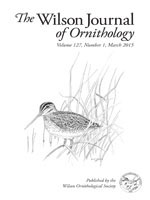Nocturnal roosting at locations disjunct from daytime foraging areas (hereafter disjunct nocturnal roosting) is a common avian behavior on both the breeding and wintering grounds but to our knowledge has not been documented in arboreal passerines during migratory stopover. We report observations of a spring migrant Yellow-rumped Warbler (Setophaga coronata) commuting to a nocturnal roost site 2.6–3.2 km north from its 5.1–9.0 ha daytime home ranges on two consecutive stopover days. We discuss the potential significance of this behavior in terms of roost habitat type, predator avoidance, and thermoregulation. We encourage those conducting telemetry studies on stopover migrants to examine existing data and, when possible, to use tracking methods that advance understanding of the behavioral ecology of nocturnal roosting and the prevalence of and causes for disjunct roosting.
How to translate text using browser tools
1 March 2015
Disjunct Nocturnal Roosting by a Yellow-rumped Warbler (Setophaga coronata) during Migratory Stopover
David L. Slager,
Paul G. Rodewald
ACCESS THE FULL ARTICLE
home range
migration
nocturnal roosting
radio-telemetry
Setophaga coronata
stopover





